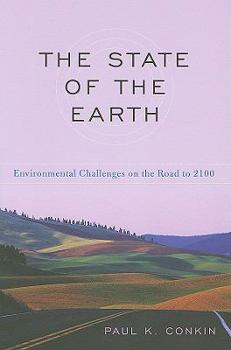The State of the Earth: Environmental Challenges on the Road to 2100
Select Format
Select Condition 
Book Overview
The pace of human progress accelerated profoundly in the twentieth century, spawning revolutionary advances in medicine, agriculture, and industry. Between 1900 and 2000, the world's population quadrupled, and production and consumption of goods increased by a factor of twelve. In The State of the Earth , award-winning historian Paul K. Conkin offers a balanced, nuanced, and ultimately hopeful assessment of the major environmental challenges that must be met after a century of torrid growth and development. Unlike many recent polemics that reduce serious environmental debates to partisan political arguments, The State of the Earth provides a thorough and scientifically informed introduction to current environmental concerns. Conkin demonstrates how the explosion in population, production, and consumption has begun to deplete critical resources such as soil nutrients and fresh water, leading to potentially widespread shortages in the world's poorest regions. Fossil fuel emissions have assured a rapid increase in greenhouse gases and contributed to rising surface and ocean temperatures, a warming that is almost certain to continue throughout the twenty-first century. Conkin explains how the complex interactions between pollution, warming, and resource depletion may threaten the planet's biodiversity and endanger innumerable species. The State of the Earth , however, is much more than a summary statement of potential catastrophes. Conkin details the long history of global conservation and environmental protection movements and places their efforts in accessible historical, theoretical, and scientific contexts. He anchors his analysis with the awareness that environmental concerns are simultaneously hotly debated political issues, variables in economic decision making, and matters of extraordinary social and cultural significance. Conkin's mission is neither to proclaim certain doom nor to suggest blithely that technological innovation and other free-market solutions will soon repair the damage already done. Rather, The State of the Earth explains the realities and consequences of ecological disruption, unsustainable growth, and environmental degradation. Conkin provides a sober and comprehensive introduction to the science and history of the environmental challenges facing humans in the new century, highlighting the need to act now on a global scale to reverse these troubling trends.
Format:Paperback
Language:English
ISBN:0813192250
ISBN13:9780813192253
Release Date:June 2009
Publisher:University Press of Kentucky
Length:320 Pages
Weight:1.17 lbs.
Dimensions:0.9" x 6.4" x 9.0"
Grade Range:Postsecondary and higher
Customer Reviews
1 rating
Can the two-centuries-long banquet of the affluent nations continue without damaging the Earth's liv
Published by Thriftbooks.com User , 17 years ago
XXXXX "In this book...I hope I have offered...an understanding of the Earth and of life on Earth as to enable [readers] to understand the planet's vulnerability to human activities. I have tried to survey the road that lead to the major environmental issues that humans face today [and help readers better understand the challenges that lie ahead on the road to 2100]. I want to help people understand why we need to attend to these problems [or issues]...This is no easy task...[since] the literature on environmental issues is now...growing exponentially every year." The above is from the preface of this clear but not overly simplistic book by Paul K. Conkin, Professor Emeritus of History at Vanderbilt University and the author of numerous books. Conkin is absolutely correct when he says that it is no easy task to help readers understand how humans have come to the environmental crossroads they face today and what the future challenges hold. Has the author succeeded in his task? In my opinion, YES and he does it in a clear, thorough, historical & scientifically informed way. The book itself is divided into five parts. All parts (consisting of two chapters each) are interesting but I found parts three and four entitled "The Human Threat" and "Climate Change" respectively particularly interesting. As well, part five entitled "Environmental Policies and Philosophies" was quite informative. Books like this can be pontifical with the authors saying what should be done or that humans should do this or that. This book is different and for me, refreshing. It explains the realities and consequences of ecological disruption, unsustainable growth, and environmental degradation. It does not proclaim doom and gloom or suggest simply that new technologies or other free-market solutions will repair the damage that's already been done. Finally, this book is well illustrated. It contains almost twenty figures (in the form of graphs, charts, tables, etc.). I found all of these revealing and informative. In conclusion, this book, in my view, is the best assemblage of historical and scientific information about our ecological problems and about how humans have reacted (especially in the United States) that I have ever read. I leave you with the last two sentences of the book's excellent afterword: "Can the affluent rest at ease and continue to enjoy high living standards with the knowledge that there is not nearly enough resources for all humans to join the feast? And in such a world, how long will the affluent be safe at their banquet? (first published late 2006; preface; acknowledgements; 5 parts or 10 chapters; a personal afterword; main narrative 285 pages; notes; index) > <br /> <br />XXXXX <br />





